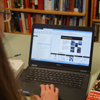In fall 2019, three weeks into my undergraduate War and Medicine class, a student asked when she could expect to see her grades in Canvas, our learning management system (LMS). What?! Since the first week, my TAs and I had regularly uploaded marks for their daily assignments. But all she saw, the student explained, was an empty gradebook.

Considering student perspectives on assignments and their experience with the work you’re asking them to do can revitalize your course. Unsplash/Kévin Hikari
A small matter, with a simple fix. But the technological issue sparked a broader pedagogical insight. Canvas, like most LMSs, has two display modes: “instructor view” and “student view.” As teachers, we spend a lot of time tinkering under the LMS instructor hood. However, course sites look quite different via student view. The LMS displays a different interface, and students see them from other perspectives.
Teachers can get caught up with what we are doing for our students. We become immersed in preparing what we’ll give them, and in responding to what they give us. I craft my interactive lecture and slides on tuberculosis sanitoria, I collect primary sources and compose their analytical assignment, and I assess their submissions. But between our preparation and our response, there is space to become better attuned to the student view—to the ways that students perceive and interact with all this material we so carefully create for them.
In order to do this, it helps to acknowledge that teaching hinges on communication. Effective assignments are not incantations that enchant the most recalcitrant student to optimal learning. Course plans are only as good as their usefulness to students, and teaching happens when students show up, interpret our plans, and act on them.
And yet, before the start of each semester, we design our courses by envisioning the future. Often, we plan alone. We create the syllabus, the calendar, and the assignments based on our highest hopes, expert knowledge, and past experiences, using best practices and the latest tools. How genuinely lovely, that quiet period of anticipation, when the semester is laid out before us in clean calendars and detailed instructions, when there are no actual students, just the ones in our heads.
When we focus on teaching as communication, we can release some of the pressure to anticipate uncertainties and control the unexpected.
In 2020, we likely feel even greater pressure to make careful plans that anticipate all manner of contingencies. We face unfamiliar digital and hybrid teaching platforms, unpredictable public health conditions, urgent social problems, and complex work-from-home environments. When we focus on teaching as communication, we can release some of the pressure to anticipate uncertainties and control the unexpected. When we see students as interlocutors, we can redirect our attention to the ways that they engage with what we offer, and discover a more adaptable, resilient way forward. Here are some suggestions:
Share assignments as living documents and invite feedback. We rarely distribute paper copies of assignments anymore. But our practices retain artifacts of that print system—most notably, the idea that once teachers prepare an assignment, we can’t change it until the next one, or until the next semester. We can relinquish the outdated norm that once an assignment has been distributed, the type is set in indelible ink. Digital documents such as Google Docs open windows of time and opportunity for students to give feedback and for us to revise.
When you “hand out” an assignment, try sharing it as a living digital document, and allow students to interact with it as you observe and respond. This approach has two advantages. First, it helps you to see how students are reading and interpreting your assignment. Second, it allows you to revise on the spot in order to communicate with them more effectively.
Let’s say, for example, that I am assigning a group project. In my History of Medicine class, students research and give class presentations about health advice for mothers and babies in the 20th-century United States. In their groups, I ask students to annotate the document. As they read, I ask them to:
- Highlight the places in the document where they feel overwhelmed or confused. Just noting these places helps me and the students to identify not just what they understand, but how they feel. It’s hard for students to translate feelings of overwhelm or confusion to actual questions.
- Write a short explanation of what the purpose of the assignment is. What do they think that they might learn through the process? How does it fit with what we’re doing in the class? Learners are motivated not just by completing tasks, but by a sense of purpose.
- Brainstorm what the assignment provokes them to think about. This prompt raises procedural and clarifications, but it always pushes students to also think about the substance of the work.
- Find the typos and errors. Students enjoy fixing their teacher’s prose. And when teachers share their writing, it models the essential role of revision and reader feedback in the craft of historical writing.
Make process visible. Whenever I meet with a student about their historical project, I end the meeting by asking them, “What you will do the next time you sit down to work on this?” Conversations about a work in progress can evaporate as they walk down the hall (or sign off Zoom). But when they leave my office or when they finish reading my feedback on a draft, they need to do something. By asking them to verbalize their plan, I am teaching them the habit of articulating their ideas as actions that can manifest as accomplishment, text, and progress.
For instance, if a student tells me that they need to “find secondary sources for my project on the history of the physical education in US high schools in the 1960s,” I ask them to specify their plan. What database will they use first? Which search words will they start with? How will they occasionally step back, think, and consider next steps? How will they keep track of their searches and results? I make space to regularly ask students to share their processes, evaluate them, and plan their next steps.
How students do what we ask them to do is often a mystery to us, and we often make erroneous assumptions about their effort based on what they produce. But their work processes are an essential part of the student view—of how they approach and experience the key activities and skills we aim to teach. When we ask them to describe honestly what they are doing, it fills in a common, vexing gap between our instructions and their interpretation of those instructions. And, when they learn to articulate concrete plans and act on them, they learn to engage in independent work rather than complete tasks.
When we ask students to “read,” we often have something much more specific in mind, and we need to communicate that to them.
Teach the verbs. When I lead pedagogy workshops, I ask teachers to choose one of their assignments and circle all the verbs. Teachers often fail to circle the basic verbs. But those are precisely the ones that cause the most trouble for students. Take, for instance, “read.” What verb causes more vexation for history teachers?
We tell students to read, but we are often disappointed in the results. We often frame this as an issue of student motivation. But it is also a communication issue. “Reading” sounds like a simple word for a straightforward action. However, we know that reading is a global verb that can entail a whole range of possible smaller actions, often completed in sequence. When we ask students to engage in global verbs such as “read,” we often have something much more specific in mind, and we need to communicate that to them.
For example, my History of Medicine class enrolls students across the disciplines. Some of my pre-med students shared that they were frustrated by how much time and energy it took to read for class. I asked them to describe just what they did, and how long it was taking them: they were reading every word, and it was taking up to six hours. At first, I shared strategies for reading more efficiently, such as previewing, scanning, and summarizing main points. But what they really needed was practice. I didn’t need to tell them, I needed to teach them. So I dedicated class time to reading, when I could observe and provide guidance as they practiced, rather than admonishments and instructions outside of that direct experience.
When we teach a verb like “reading,” we discover that what we are actually teaching are repertoires of activity. I want students to learn to read a photograph of patients on a sanitorium porch, and the argument of Helen Bynum’s Spitting Blood, and my assignment asking them to formulate a historical question about public health posters. Our teaching task, then, is to communicate reading as a rich array of actions and to help students to draw upon this repertoire skillfully. It only works when we make this clear, and when we have ways of seeing them in action.
These suggestions share a core value: curiosity. Now more than ever, we need pedagogy that is resilient, flexible, and student-centered. When we consider the student view, we find ways to see and meet them as they are, however things are.
Monique Dufour is assistant collegiate professor of history and director of graduate student professional development for the College of Liberal Arts and Human Sciences at Virginia Tech.
Tags: Features Teaching & Learning K-16 Education Teaching Resources and Strategies

This work is licensed under a Creative Commons Attribution-NonCommercial-NoDerivatives 4.0 International License. Attribution must provide author name, article title, Perspectives on History, date of publication, and a link to this page. This license applies only to the article, not to text or images used here by permission.
The American Historical Association welcomes comments in the discussion area below, at AHA Communities, and in letters to the editor. Please read our commenting and letters policy before submitting.
Comment
Please read our commenting and letters policy before submitting.








